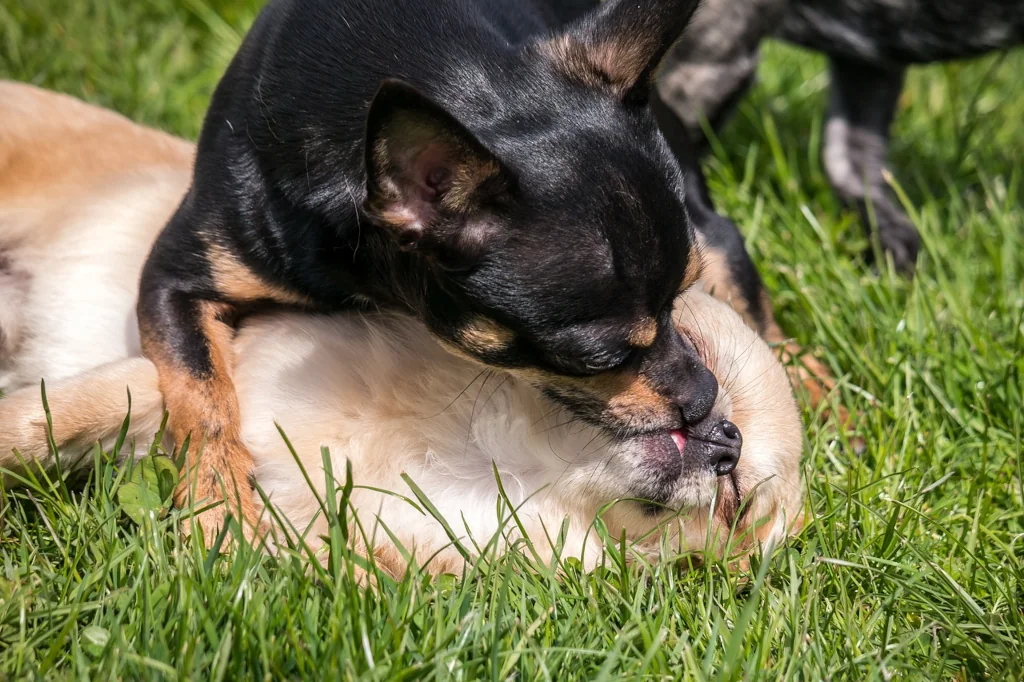Understanding the Curious Behavior: Why Does My Dog Hump Other Dogs’ Faces?
Dogs are fascinating creatures with a wide range of behaviors that can sometimes leave us puzzled. One such behavior that often raises eyebrows is when a dog humps the face of another dog. While it may seem strange or even inappropriate to us humans, this behavior is actually quite common among dogs. In this article, we will delve into the reasons behind why dogs engage in this behavior, shedding light on the possible motivations and underlying factors.
Firstly, it is essential to recognize that humping is a natural behavior for dogs, and it serves various purposes in their social interactions. Dogs, as social animals, use humping as a form of communication and expression. It can be a way for them to exert dominance or establish their position within a group. Just like other forms of play or interaction, humping can be a part of their social dynamics and hierarchy.
Additionally, humping can also be driven by sexual motivations. Dogs, especially those that are not neutered or spayed, may engage in mounting behavior as a result of sexual arousal. This behavior is more commonly observed in intact males, but females can also exhibit it. It is important to note that humping does not necessarily indicate sexual intent or aggression; rather, it can be a natural response to certain stimuli or situations.
Furthermore, humping can be a manifestation of stress or anxiety in dogs. When dogs are placed in unfamiliar or overwhelming environments, they may resort to humping as a coping mechanism. This behavior can serve as a way for them to release tension or redirect their anxiety. It is crucial for dog owners to pay attention to their pets’ overall well-being and address any underlying stressors that may contribute to this behavior.
While humping other dogs’ faces may be a normal behavior within the canine world, it is essential for dog owners to understand the context and ensure the safety and comfort of all dogs involved. Some dogs may not appreciate or tolerate this behavior, leading to potential conflicts or discomfort. As responsible pet owners, it is our responsibility to intervene and manage these interactions appropriately.
In conclusion, humping other dogs’ faces is a complex behavior that can have multiple motivations. Dogs may engage in this behavior to assert dominance, express social hierarchy, experience sexual arousal, or alleviate stress. Understanding the underlying reasons behind this behavior can help us better comprehend our furry friends and ensure their well-being. In the following sections, we will explore practical recommendations to manage and address this behavior effectively.

Why Does My Dog Hump Other Dogs’ Faces
The Curious Behavior: Why Does My Dog Hump Other Dogs’ Faces?
Social Dynamics and Dominance
One of the key reasons why dogs engage in humping other dogs’ faces is related to their social dynamics and dominance hierarchy. Dogs are pack animals, and within a pack, there is a need to establish and maintain a social order. Humping can be a way for dogs to assert dominance or establish their position within the group. It is a form of communication that helps them convey their status and maintain social balance.
It is important to note that dominance-related humping is not limited to intact males. Both male and female dogs can exhibit this behavior, although it may be more commonly observed in intact males. This behavior is not necessarily aggressive but rather a way for dogs to express their social standing and maintain order within their social group.
Sexual Motivations
Another common reason for dogs humping other dogs’ faces is related to sexual motivations. This behavior is more prevalent in intact males, especially during the mating season or when they encounter a female in heat. Humping can be a natural response to sexual arousal and a way for dogs to release pent-up sexual energy.
It is worth noting that humping does not always indicate a desire to mate. Dogs may engage in this behavior even in the absence of a receptive partner. Neutered or spayed dogs can also exhibit humping behavior, although it may be less frequent. In such cases, humping may be driven by residual sexual behaviors or simply a response to certain stimuli.
Stress and Anxiety
Humping can also be a manifestation of stress or anxiety in dogs. When dogs find themselves in unfamiliar or overwhelming situations, they may resort to humping as a coping mechanism. This behavior allows them to release tension and redirect their anxiety.
It is crucial for dog owners to be aware of their pet’s stress levels and identify potential triggers. Common stressors can include changes in the environment, separation anxiety, or exposure to new or challenging situations. By addressing these underlying stressors and providing appropriate outlets for relaxation and anxiety management, owners can help reduce humping behavior stemming from stress.
Practical Recommendations
1. Provide Adequate Exercise and Mental Stimulation
Regular exercise and mental stimulation are essential for a dog’s overall well-being. Engaging in physical activities and providing mental challenges can help reduce stress and redirect excessive energy. Make sure to provide your dog with daily walks, playtime, and interactive toys to keep them mentally and physically stimulated.
2. Neuter or Spay Your Dog
If you have not already done so, consider neutering or spaying your dog. This can help reduce sexual motivations behind humping behavior, especially in intact males. Consult with your veterinarian to determine the appropriate time for the procedure and discuss any potential behavioral benefits.
3. Monitor and Manage Interactions
When your dog interacts with other dogs, it is essential to monitor their behavior and intervene if necessary. Not all dogs appreciate or tolerate humping, and it can lead to conflicts or discomfort. If you notice your dog attempting to hump another dog’s face, redirect their attention with a command or remove them from the situation if needed.
4. Seek Professional Help
If humping behavior becomes excessive, persistent, or causes distress to your dog or others, consider seeking guidance from a professional dog trainer or animal behaviorist. They can assess the underlying factors contributing to the behavior and provide tailored strategies to manage and modify it effectively.
Conclusion
In conclusion, understanding the behavior of dogs, such as why they might engage in activities like humping other dogs’ faces, is crucial for pet owners seeking to ensure harmonious interactions and well-being for their furry companions. For a deeper dive into this behavior, its causes, and how to manage it, visit Geepets.com where you can find a comprehensive article on “Why Does My Dog Hump Other Dogs’ Faces.” This behavior can range from dominance assertion, playfulness, to even a sign of stress or excitement.

Why Does My Dog Hump Other Dogs’ Faces
For additional insights and professional advice on dog behavior and training techniques, consider exploring resources like the American Society for the Prevention of Cruelty to Animals (ASPCA) at aspca.org, which offers a wealth of information on dog behavior, health, and welfare. Understanding these aspects of canine behavior is essential for fostering a positive and healthy relationship between dogs and their owners.
Practical Recommendations to Address Humping Behavior
1. Provide Adequate Exercise and Mental Stimulation
Regular exercise and mental stimulation are crucial in managing humping behavior. Dogs that are physically and mentally tired are less likely to engage in excessive humping. Ensure your dog receives daily walks, playtime, and interactive toys to keep them engaged and satisfied.
2. Neuter or Spay Your Dog
Consider neutering or spaying your dog, especially if they exhibit persistent humping behavior. This procedure can help reduce sexual motivations behind humping, particularly in intact males. Consult with your veterinarian to discuss the appropriate timing and potential behavioral benefits of the procedure.
3. Implement Positive Reinforcement Training
When dealing with the question of “Why Does My Dog Hump Other Dogs’ Faces,” it’s crucial to approach the situation with understanding and positive reinforcement techniques. Observing your dog attempting this behavior can be concerning and embarrassing, but understanding “Why Does My Dog Hump Other Dogs’ Faces” can help you address the issue more effectively. To redirect your dog’s behavior when you catch them in the act, immediately interrupt them and guide their attention towards an appropriate alternative, such as a toy or a command. This method not only helps in managing the behavior linked to “Why Does My Dog Hump Other Dogs’ Faces” but also reinforces good behavior without punishment.
Incorporating positive reinforcement when your dog responds well to the redirection is key in answering the “Why Does My Dog Hump Other Dogs’ Faces” dilemma. Reward them with praise, treats, or playtime to encourage them to make positive choices instead. Each time you successfully redirect your dog from attempting to hump another dog’s face, and they respond to your redirection, you are one step closer to understanding and resolving the “Why Does My Dog Hump Other Dogs’ Faces” issue. This positive reinforcement strengthens the bond between you and your dog, making it easier to manage and eventually eliminate the unwanted behavior associated with “Why Does My Dog Hump Other Dogs’ Faces.”
4. Manage and Monitor Interactions
Consider neutering or spaying your dog, especially if you’re frequently asking yourself, “Why does my dog hump other dogs’ faces?” This persistent behavior, often observed in intact males, can be quite concerning and embarrassing for pet owners. Neutering or spaying your dog can help reduce the sexual motivations behind the question, “Why does my dog hump other dogs’ faces?” It’s a common query among pet owners who witness their dog engaging in this behavior, which is not only directed towards other dogs but can also be a display of dominance, playfulness, or stress relief.
Consulting with your veterinarian is crucial to discuss the appropriate timing and potential behavioral benefits of the procedure in relation to the behavior of “Why does my dog hump other dogs’ faces?” They can provide you with detailed insights into how neutering or spaying might help address the root of the problem, potentially decreasing or eliminating the behavior that leads you to wonder, “Why does my dog hump other dogs’ faces?”
5. Address Underlying Stressors
Identifying and addressing any underlying stressors that may contribute to humping behavior is crucial, especially if you’re wondering, “Why does my dog hump other dogs’ faces?” Changes in the environment, separation anxiety, or exposure to new or challenging situations can trigger stress in dogs, leading to the question, “Why does my dog hump other dogs’ faces?” Creating a calm and secure environment is essential in these cases. Provide them with a safe space, and consider using relaxation techniques, such as calming music or aromatherapy, to help alleviate their anxiety, which could be a factor if you’re asking yourself, “Why does my dog hump other dogs’ faces?”
Understanding the reasons behind the question, “Why does my dog hump other dogs’ faces?” involves recognizing that stress and anxiety can play significant roles in such behavior. By taking steps to minimize these stressors, you can help address the behavior effectively. Whether it’s through environmental adjustments, the introduction of calming practices, or both, the goal is to create a more relaxed atmosphere for your dog. This approach not only helps in reducing stress-related behaviors but also in answering the concerning question of, “Why does my dog hump other dogs’ faces?” with actionable solutions.

Why Does My Dog Hump Other Dogs’ Faces
6. Seek Professional Help
If the question “Why Does My Dog Hump Other Dogs’ Faces” is at the forefront of your concerns and humping behavior persists or causes distress to your dog or others, it’s crucial to seek guidance from a professional dog trainer or animal behaviorist. They are well-equipped to delve into the specific reasons behind “Why Does My Dog Hump Other Dogs’ Faces” and can assess the underlying factors contributing to this behavior. With professional help, you can obtain tailored strategies to manage and modify it effectively, addressing the root of “Why Does My Dog Hump Other Dogs’ Faces.”
Professional guidance can be particularly beneficial in complex cases or when dealing with underlying behavioral issues that prompt you to ask, “Why Does My Dog Hump Other Dogs’ Faces?” This expertise ensures that the approach to modifying your dog’s behavior is not only comprehensive but also specifically targets the unique reasons behind “Why Does My Dog Hump Other Dogs’ Faces,” leading to more effective and lasting solutions.
7. Practice Patience and Consistency
Addressing humping behavior requires patience and consistency. Understand that behavior change takes time, and progress may be gradual. Be consistent in implementing training techniques, providing mental and physical stimulation, and managing interactions. With time and dedication, you can help your dog develop alternative behaviors and reduce their inclination to hump other dogs’ faces.
Remember, each dog is unique, and what works for one may not work for another. Tailor your approach to suit your dog’s individual needs and consult with professionals when necessary. By implementing these practical recommendations, you can effectively manage and address humping behavior while promoting a harmonious and balanced relationship with your furry friend.






















